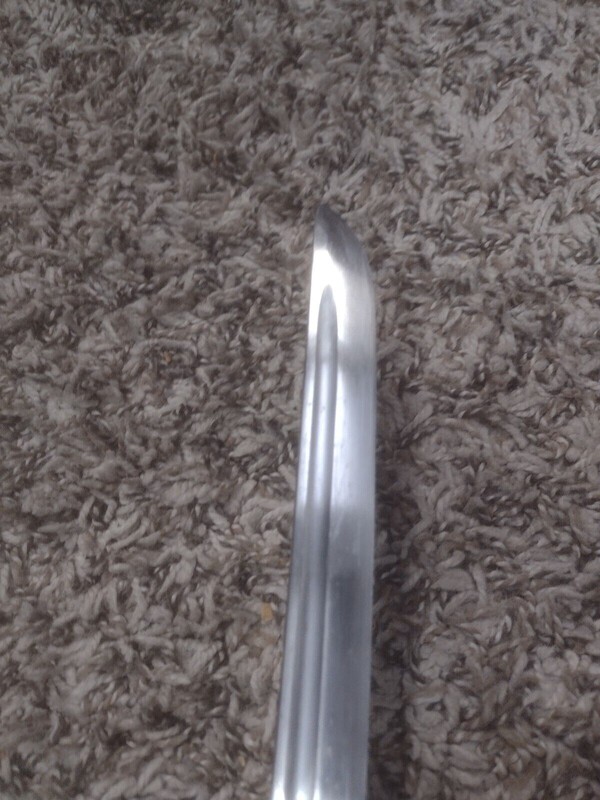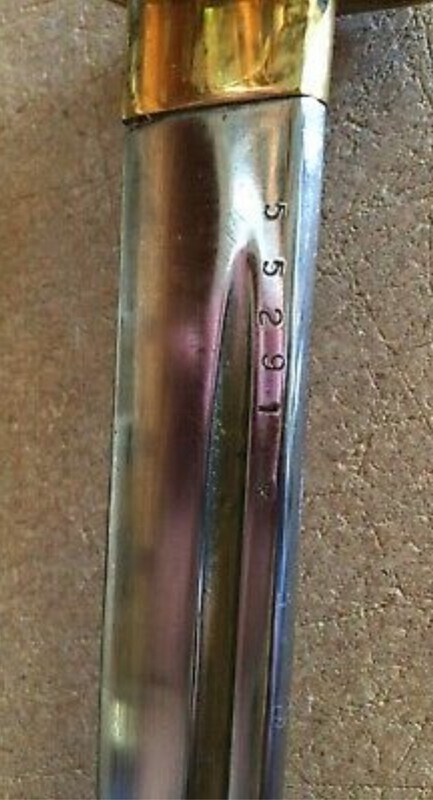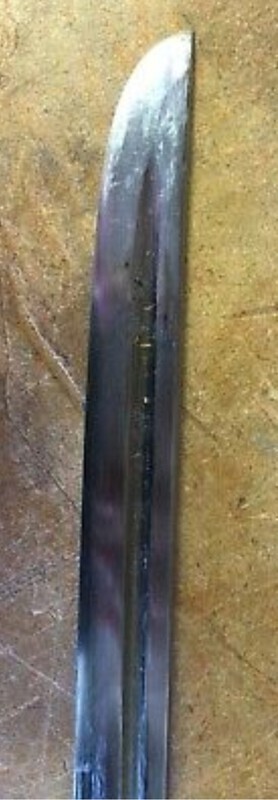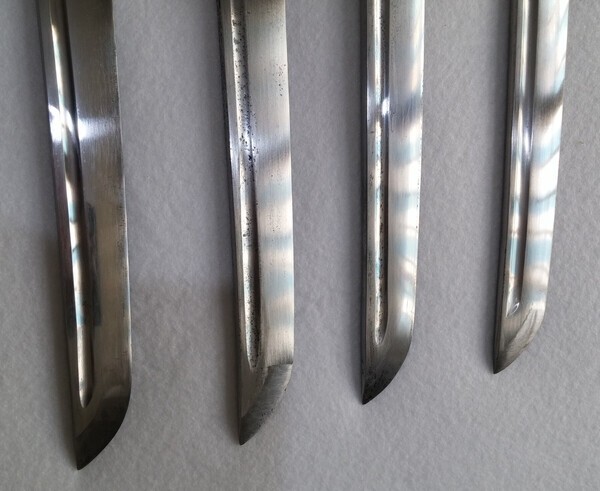-
Posts
1,402 -
Joined
-
Last visited
-
Days Won
11
Content Type
Profiles
Forums
Events
Store
Downloads
Gallery
Everything posted by Shamsy
-
The rust on the scabbard looks old and stable. You'll likely do more damage messing around with it than just leaving it alone.
-
They all look like fakes from China to me.
-
The board will tell you if you ask. There are many indicators of fakes. Lots of details can point to a sword being a fake. Lots of those same details apply to real swords. You need to consider the whole sword to make an informed decision. Look through the fake thread for example. Read books. Ask questions. It's mostly an experience thing, you just get a feel for it after a while.
-
I agree with Bruce here, Thomas. The bohi is 'good' compared to some repros and fakes. Neat and rounded at the top, scooping up at the bottom (though this can also be more of a kissaki shape too). A lot of fake blades in 95s are scooped at both ends. Looks cheap and presumably is. If all fake 95s had blades like this, it'd be a -slightly- harder game to pick them. Having said that, the BUT. There is not a definitive style behind the bohi found on 95s. I've illustrated this in the fake thread (page 6) with example pictures, which I'll copy here. They are the two with multiple blades shown. The fake thread also has a lot of different styles of bohi on fake examples, some are scooped, some neat like this. So I can't really say anything more than this bohi is better than worse examples. It's better than some but not unusual. Quite underwhelming for such a long post I'm afraid.
-
Thanks to Brian and the mods for continuing to bear the burden of organising and mediating an entire forum. You do a fantastic job. Thanks to everyone who provides such expertise in the nihonto field. Not an area I know much about at all, so I appreciate those that take the time to answer my banal questions. Thanks to everyone that I see regularly in the military swords corner of the forum. Helpful, enthusiastic bunch and some great research and learning there. Appreciate the time you all dedicate to it and hope I can in some small way contribute back to the group.
-
It doesn't look like a 95 or as though it is trying to be one. Could we please endeavour to keep this thread specific to educational information and examples of genuine VS fake Type 95 swords.
-
Patina is an important part of these swords. Other than stabilising actuve rust, it really is best to just leave it alone. Other than the blade, there is nothing I see that would benefit from any kind of cleaning. As Bruce has already said though, these are not art swords, so if you really want to try and clean it, just try not to remove the protective coating on the brass (the brownish tint), try not to remove any paint, try not to remove stabilised black rust, try not to damage anything (like soft brass screws).
-
Not paint; most of the deeper serial numbers are dark like that, from temper, grime or age. Check out the example on page 6 of the Fake 95 thread to see what I mean.
-
That's the Nagoya army arsenal stamp. Looks fine to me but you've not provided much more than a fuzzy pic. Some of the shallow stamps looks cut, but there is a huge variation so don't stress it. I've posted comparison photos between swords a dozen times or so here which make that pretty clear that variation in quality is okay https://www.militaria.co.za/nmb/topic/19914-fake-type-95-nco-swords/page/6/ I assume that's from an iron fuchi sword in the 200,000 range? Side latch?
-
Complete and genuine 95. Wipe the cosmoline off the blade with white alcohol and then oil. Only oil the blade and lightly. Leave the rest alone and try to use gloves on the painted parts. You've already identified the sword as Suya with the Kokura 'cannon balls' stamp and the Tokyo 1st Army Arsenal inspection stamp in the middle. Nothing much else to share.
-
Just looking at that belt-sander bohi should be enough to make anyone shy away. The tsuba is really thin too. Guess price inflation of brass is hitting the repro market hard.
-
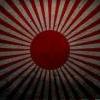
Light/Misstrikes Type 95 Serial Numbers, Common?
Shamsy replied to knd643's topic in Military Swords of Japan
Seeing mis-struck stamps and mistakes is always an enjoyable phenomenon. Nothing much to add to what Bruce has already said. Not common, but plenty of examples across all 95 patterns. Examples may be: Stamps in wrong order Numbers stamped horizontally Subcontractor stamped twice Half stamps Over-struck mistakes Stamps upside-down Particularly prevalent are weak strikes on iron fuchi and the pattern 5 '3' stamp being badly mashed. -
Certainly looks old. Not saying this is the case, BUT bear in mind that of it was painted gold around the time it was brought back as a souvenir, you could reasonably expect it to exhibit a patina like that. That's what makes these things so difficult to determine.
-
Pretty much what the others have already told you. Lovely sword, well worth getting if the serial numbers match.
-

Unusual top seppa Pattern 1 copper Type 95
Shamsy replied to robinalexander's topic in Military Swords of Japan
Correct tsuba, then. That's a good sign. -

Unusual top seppa Pattern 1 copper Type 95
Shamsy replied to robinalexander's topic in Military Swords of Japan
Not always perfect fits, @Bruce Pennington (especially later on), but the latch should actually be flush to the hole in the saya throat. You obviously didn't find a slip of paper with any details of the arsenal refurbish/repairs (I assume you'd have told us). Bit weird, not sure what to make of that. -
Thanks, Bruce. Seen a few and pretty sure I've got a couple. Extra stamps are always interesting and pretty unusual.
-
Patina on the hilt is so far off from the saya, definitely a repaint of black, much later than the hilt. Strongly expect there would be the standard paint remaining somewhere on the saya if carefully examined. I wonder if the allies repainted captured equipment to prevent decay until they decided what to do with it. Not a bad theory and as solid as anything else.
-

Japanese Swords Made In China During World War II
Shamsy replied to Kiipu's topic in Military Swords of Japan
Thinking these are likely candidates. Better quality than field made, worse than Japanese made, unusual markings, two grades and suspected Chinese stamps, not to mention the inscription on the one example. Thoughts? -

How to determine a fake from authentic
Shamsy replied to Adam001's topic in Military Swords of Japan
Grey pretty much has it. I guess experience is the best solution, so take someone who can help if possible. Otherwise things to look for might be: Quality - while there is a huge fluctuation, if the sword and fittings look to be high quality work, more chance it's genuine Colours - try to get an idea of genuine colours found on swords and stick to those Patina - can be faked, but genuine patina from age and casual wear is extremely difficult to mimic Symbols, carvings - Chinese love to plaster cheap looking carvings and symbols on fakes Look, nothing will beat careful study and hard won experience. If in any doubt, avoid it and wait until you've earned these. Still plenty of swords out there and you're unlikely to find any real bargains at any sizable event anymore. No hurry. -

Minty copper NCO sword noted on social media platform
Shamsy replied to zook's topic in Military Swords of Japan
Noticed that, Thomas. It also has the standard half-circle drag, as opposed to the horseshoe shape. Which is good, because it confirms what I've said previously about the transition occurring between 700 and 800. -

Minty copper NCO sword noted on social media platform
Shamsy replied to zook's topic in Military Swords of Japan
I'd rather have the sword on my shelf, Bruce! -
Agreed, very likely the case, but the least we can do is see the nakago and provide a definitive conclusion. Seen too many swords incorrectly dismissed to jump to 'fake' without being thorough.
-
The thing that always stands out immediately to me with these Iijima is the paint. It's just not the right shade. Before seeing anything further it sends up a warning flare to look closer.





